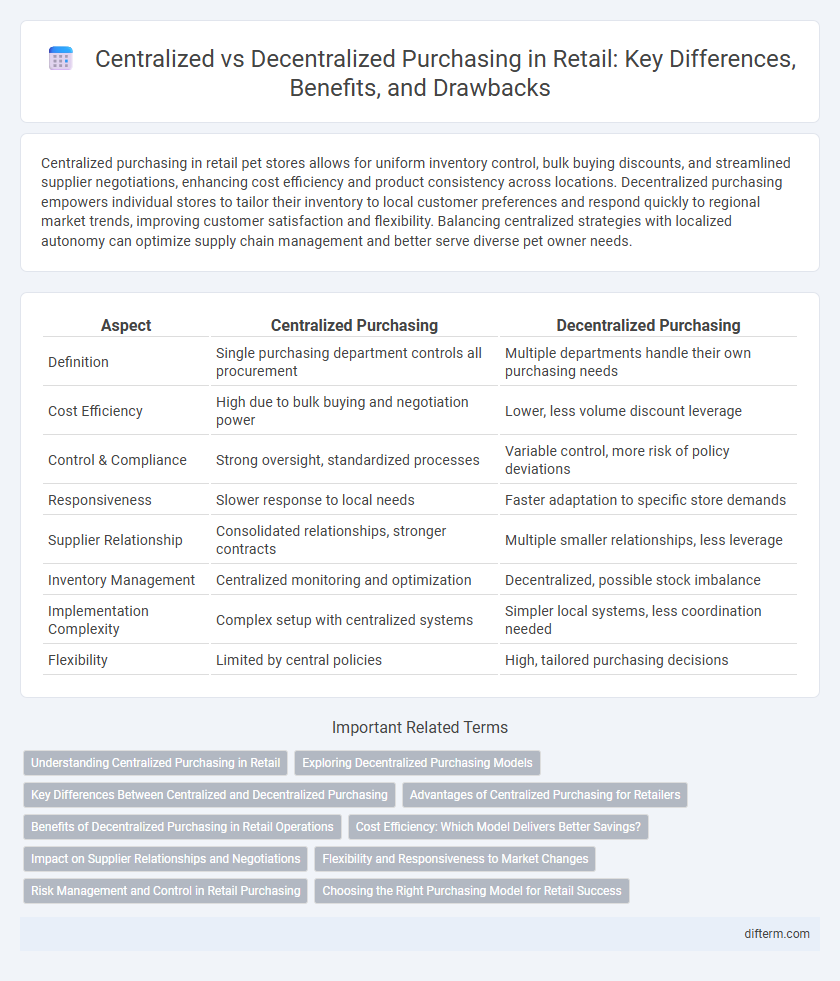Centralized purchasing in retail pet stores allows for uniform inventory control, bulk buying discounts, and streamlined supplier negotiations, enhancing cost efficiency and product consistency across locations. Decentralized purchasing empowers individual stores to tailor their inventory to local customer preferences and respond quickly to regional market trends, improving customer satisfaction and flexibility. Balancing centralized strategies with localized autonomy can optimize supply chain management and better serve diverse pet owner needs.
Table of Comparison
| Aspect | Centralized Purchasing | Decentralized Purchasing |
|---|---|---|
| Definition | Single purchasing department controls all procurement | Multiple departments handle their own purchasing needs |
| Cost Efficiency | High due to bulk buying and negotiation power | Lower, less volume discount leverage |
| Control & Compliance | Strong oversight, standardized processes | Variable control, more risk of policy deviations |
| Responsiveness | Slower response to local needs | Faster adaptation to specific store demands |
| Supplier Relationship | Consolidated relationships, stronger contracts | Multiple smaller relationships, less leverage |
| Inventory Management | Centralized monitoring and optimization | Decentralized, possible stock imbalance |
| Implementation Complexity | Complex setup with centralized systems | Simpler local systems, less coordination needed |
| Flexibility | Limited by central policies | High, tailored purchasing decisions |
Understanding Centralized Purchasing in Retail
Centralized purchasing in retail consolidates product procurement decisions and orders within a single department or location, enabling streamlined operations and stronger negotiation power with suppliers. This approach enhances cost efficiency through bulk buying, consistent quality control, and standardized inventory management across multiple stores. Retailers employing centralized purchasing benefit from improved supplier relationships and reduced administrative overhead, leading to optimized supply chain performance.
Exploring Decentralized Purchasing Models
Decentralized purchasing models empower individual retail locations to make procurement decisions tailored to local market demands, enhancing responsiveness and customer satisfaction. This approach often leads to increased flexibility in inventory management and faster adaptation to regional trends, driving competitive advantage. Retailers adopting decentralized purchasing leverage data analytics at store level to optimize product selection and reduce stockouts, improving overall operational efficiency.
Key Differences Between Centralized and Decentralized Purchasing
Centralized purchasing consolidates procurement decisions within a single department, enabling bulk buying, standardized vendor contracts, and streamlined inventory management which reduces costs and enhances negotiation leverage. Decentralized purchasing allows individual stores or departments to manage their own procurement, resulting in faster response to local demand, greater flexibility, and tailored product selection according to customer preferences. Key differences include control and accountability concentration, purchasing volume consolidation, and the balance between cost efficiency versus localized agility in meeting consumer needs.
Advantages of Centralized Purchasing for Retailers
Centralized purchasing in retail streamlines procurement by consolidating orders, leading to significant cost savings through bulk buying and stronger supplier negotiation power. It enhances inventory management accuracy and reduces duplication, ensuring consistent product availability across all store locations. This approach improves standardization of quality and purchasing processes, ultimately driving operational efficiency and better compliance with procurement policies.
Benefits of Decentralized Purchasing in Retail Operations
Decentralized purchasing in retail operations enhances responsiveness by allowing individual store managers to make procurement decisions tailored to local customer preferences and market conditions. This approach improves inventory management and reduces lead times by enabling quicker sourcing and order placements at the store level. Enhanced flexibility and localized control contribute to higher customer satisfaction and more efficient stock turnover.
Cost Efficiency: Which Model Delivers Better Savings?
Centralized purchasing consolidates buying power, leveraging bulk discounts and supplier negotiations to deliver significant cost savings for retail operations. Decentralized purchasing may increase responsiveness but often incurs higher overall costs due to smaller order volumes and duplicated administrative expenses. Retailers aiming for cost efficiency typically benefit more from centralized procurement models that optimize supplier contracts and reduce inventory carrying costs.
Impact on Supplier Relationships and Negotiations
Centralized purchasing in retail strengthens supplier relationships by consolidating orders, leading to higher volume discounts and streamlined negotiations. Decentralized purchasing allows individual stores to tailor orders to local demand, fostering closer, more flexible supplier interactions but potentially reducing bargaining power. Balancing centralized control with localized supplier engagement optimizes negotiation outcomes and sustains long-term supplier partnerships.
Flexibility and Responsiveness to Market Changes
Centralized purchasing enables retailers to achieve consistent pricing and bulk discounts but often reduces flexibility and slows responsiveness to market fluctuations. In contrast, decentralized purchasing empowers local stores to quickly adapt to regional trends and customer preferences, enhancing agility in rapidly changing markets. Retailers must balance centralized cost efficiency with decentralized responsiveness to optimize supply chain performance.
Risk Management and Control in Retail Purchasing
Centralized purchasing in retail enhances risk management by consolidating supplier evaluation and contract negotiation, reducing exposure to unreliable vendors and inconsistent pricing. Decentralized purchasing increases flexibility but poses challenges in maintaining uniform quality standards and controlling procurement fraud across multiple locations. Effective control mechanisms in centralized systems include standardized approval workflows and centralized data analytics to monitor compliance and supplier performance.
Choosing the Right Purchasing Model for Retail Success
Centralized purchasing in retail streamlines procurement processes, reduces costs through bulk buying, and ensures consistent product quality across all stores. Decentralized purchasing enables individual stores to respond quickly to local customer preferences and market trends, fostering greater flexibility and faster decision-making. Retailers must evaluate factors like store size, geographic distribution, and product variety to choose a purchasing model that maximizes efficiency and customer satisfaction.
centralized purchasing vs decentralized purchasing Infographic

 difterm.com
difterm.com